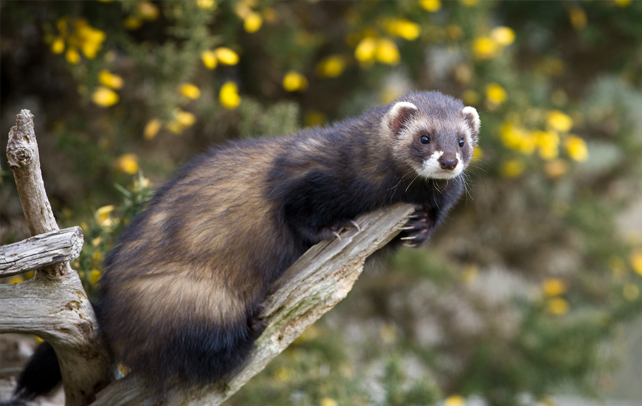Amazing Facts About Ferret

Ferrets belong to the family of Mustelidae, with minks, skunks, weasels, otters and badgers as their related cousins. However, it’s the polecats to which ferrets are closely related, and even have been bred with them, resulting in hybrids that have caused damage to the fauna. Domesticated for thousands of years, a ferret is a wild animal at heart, albeit unaggressive (to humans, unless threatened) and quite cuddly and has been associated with man as long as cats. And though it may seem an innocent mammal, make no mistakes, it is not so, for its ability to kill rabbits and rats makes it a cute killer. These fast, energetic animals are furry, and to keep them is fun. But what are they like? What is so interesting about them that have made them the third most popular pet in US? Read the article to find the answers.
Fast Facts
Kingdom: Animalia
Phylum: Chordata
Subphylum: Vertebrata
Class: Mammalia
Order: Carnivora
Family: Mustelidae
Genus: Mustela
Species: M.putorius
Subspecies: M.p.furo
Length: 37 to 70 cm, including the tail
Weight: 0.7 kg to 1.5 kg
Average Life Span: About 8 years when kept as pets, 5 to 6 years in the wild
Diet: Carnivores; rodents, amphibians, rabbits, eggs, birds, and insects
Range: Eastern and Southern Africa.
Habitat: Open savannas and grasslands, near a permanent source of water
Average Life: 7 to 10 years
Age of Sexual Maturity: 6 to 8 months
Gestation Period: About 42 days
Litter Size: 3 to 7
Interesting And Fun Facts About Ferrets
- Ferrets are dimorphic, both sexes having different morphology and ornamentation when put against each other.
- Male ferrets are larger than females and have usually brown, black or mixed fur.
- The eyesight of ferrets is weak but they have a strong sense of hearing and smell.
- A new born ferret is so small that it can fit in the palm of a 2 year old child.
- The male ferrets are called a ‘hob’ and the females are called ‘jill’. Their babies are called as ‘kits’. And the group is known as ‘business’.
- Ferrets can be housetrained and made to learn tricks as well.
- Ferrets are deep sleepers; they sleep for about 18 hours a day and it takes around 15 minutes to wake them up.
- Ferrets like to sleep in most inconvenient places and awkward positions. When in the wild, they make burrow, and prefer to sleep in an enclosed area.
- Some of the common names by which they are called are: fuzzy, fuzzball, fert, speedbump, woozel, and furball etc.
- Queen Victoria raised albino ferrets and even gifted them to her near and dear ones.
- Though they have a coat for summers and winters, ferrets are more suitable to cold and suffer when the temperatures exceed 20˚C.
- They cannot survive on their own and usually starve within 4 days.
- The smell from ferrets comes from their skin glands and not from scent glands.
- The ferrets become sexually mature at 5 to 6 months; the females, specially, must be bred or spayed, else they can go into prolong heat and eventually die.
- Their mating season is between spring and summer. After a gestation period of about 42 days, the female gives birth to 3 to 7 kits on average.
- The kits are born deaf and with their eyes closed. Between 3 to 5 weeks of age, they open their eyes and begin to listen to various sounds.
- The kits are weaned at 2-8 weeks and start gaining weight as they reach 4 months of age.
- The ferrets are native to Africa and were domesticated in Europe and introduced in America in the 17th century.
- Ferrets are playful and tend to live in groups.
- Black footed ferret, one of the species of ferrets, also known as American Polecat is the native of the great plains of North America and loves to live and hunt alone.
- Ferrets are crepuscular animals, which means, they are most active during dawn and dusk.
- Ferrets perform a dance, commonly known as weasel war dance, which is a frantic series of sideways hops, and bumping into things.
- Ferrets are quite enthusiastic animals: least aggressive and mostly friendly and playful.
- Ferrets make a distinct hissing noise when they are agitated or sad.
- There are different types of ferrets with different fur colouration: the black masked and buff coloured Fitch ferrets, pink eyes and white coloured Albino Ferrets, and lighter tan with brown marks Siamese ferret.
- There are several diseases with which ferrets are affected but the most serious is the canine distemper and unusual consequence of prolonged heat in female ferrets.
- The heart rate of ferrets is 200 to 250 per minute.
- Ferrets were used to protect the grain stores from rodents before the World War II. Even today, they are used to hunt rabbits in some parts of the world.
- Their lean bodies help them to chase out the rodents and rabbits from their burrows. The expression ferret out came from this behaviour.
- Their predators are owls, foxes and badgers and their main prey is mice, rabbits and gophers.
- The word ‘Ferret’ comes from Latin and it means ‘thief’, which is the same as the meaning of the word mouse.
- Old paintings and tapestries reveal that ferrets have been kept as pets for thousands of years. Even today, they are kept as pets in several countries including the US, UK and Japan.
- A ferret is the third most common pet in North America.









